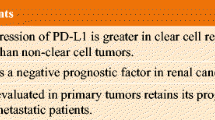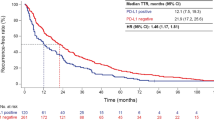Abstract
The prognostic value of programed death-ligand 1 (PD-L1) in urothelial carcinoma (UC) has been assessed in previous studies, while the results remain controversial and heterogeneous. Therefore, we performed this meta-analysis to explore the prognostic effect of PD-L1 in patients with UC. PubMed, Embase and Web of Science were searched to identify the studies. Hazard ratios (HR) with 95% confidence interval (95% CI) and clinicopathological factors were extracted from included studies. A total of 1819 patients with UC from 11 published studies were incorporated. The results of meta-analysis showed that positive PD-L1 expression was significantly associated with poorer overall survival (OS) (HR 1.59, 95% CI 1.05–2.40) and disease-free survival (DFS) (HR 1.83, 95% CI 1.03–3.25), but not recurrence-free survival. Moreover, in the subgroup analysis, significant associations between PD-L1 expression and OS or DFS were found in bladder UC, the cutoff value of positive expression of PD-L1 ≥ 5% and the expression of PD-L1 on the tumor cell membrane. Interestingly, positive PD-L1 expression was correlated with poorer pathological T stage (OR 2.03, 95% CI 1.46–2.82). Our meta-analysis implies that PD-L1 might be a valuable biomarker of poor prognosis for UC, especially bladder UC, although further large-scale and well-designed studies are warranted to verify the prognostic value of PD-L1 for UC.







Similar content being viewed by others
References
Siegel RL, Miller KD, Jemal A. CA: a cancer journal for clinicians. Cancer Stat. 2017;67(1):7–30. https://doi.org/10.3322/caac.21387.
Roupret M, Babjuk M, Comperat E, et al. European Association of Urology Guidelines on upper urinary tract urothelial carcinoma: 2017 update. Eur Urol. 2018;73(1):111–22. https://doi.org/10.1016/j.eururo.2017.07.036.
Chen L, Han X. Anti-PD-1/PD-L1 therapy of human cancer: past, present, and future. J Clin Investig. 2015;125(9):3384–91. https://doi.org/10.1172/jci80011.
Xu-Monette ZY, Zhang M, Li J, Young KH. PD-1/PD-L1 blockade: have we found the key to unleash the antitumor immune response? Front Immunol. 2017;8:1597. https://doi.org/10.3389/fimmu.2017.01597.
Powles T, Necchi A, Rosen G, Hariharan S, Apolo AB. Anti-Programmed cell death 1/ligand 1 (PD-1/PD-L1) antibodies for the treatment of urothelial carcinoma: state of the art and future development. Clin Genitourin Cancer. 2017. https://doi.org/10.1016/j.clgc.2017.11.002.
Afreen S, Dermime S. The immunoinhibitory B7-H1 molecule as a potential target in cancer: killing many birds with one stone. Hematol Oncol Stem Cell Ther. 2014;7(1):1–17. https://doi.org/10.1016/j.hemonc.2013.09.005.
Zou W, Wolchok JD, Chen L. PD-L1 (B7-H1) and PD-1 pathway blockade for cancer therapy: mechanisms, response biomarkers, and combinations. Sci Transl Med. 2016;8(328):328rv4. https://doi.org/10.1126/scitranslmed.aad7118.
Ceeraz S, Nowak EC, Noelle RJ. B7 family checkpoint regulators in immune regulation and disease. Trends Immunol. 2013;34(11):556–63. https://doi.org/10.1016/j.it.2013.07.003.
Berghoff AS, Kiesel B, Widhalm G, et al. Programmed death ligand 1 expression and tumor-infiltrating lymphocytes in glioblastoma. Neuro Oncol. 2015;17(8):1064–75. https://doi.org/10.1093/neuonc/nou307.
Riobello C, Vivanco B, Reda S, et al. Programmed death ligand-1 expression as immunotherapeutic target in sinonasal cancer. Head Neck. 2018;40(4):818–27. https://doi.org/10.1002/hed.25067.
Cha YJ, Kim HR, Lee CY, Cho BC, Shim HS. Clinicopathological and prognostic significance of programmed cell death ligand-1 expression in lung adenocarcinoma and its relationship with p53 status. Lung Cancer. 2016;97:73–80. https://doi.org/10.1016/j.lungcan.2016.05.001.
Jiang D, Xu YY, Li F, Xu B, Zhang XG. The role of B7-H1 in gastric carcinoma: clinical significance and related mechanism. Med Oncol. 2014;31(11):268. https://doi.org/10.1007/s12032-014-0268-1.
Zhao LW, Li C, Zhang RL, et al. B7-H1 and B7-H4 expression in colorectal carcinoma: correlation with tumor FOXP3(+) regulatory T-cell infiltration. Acta Histochem. 2014;116(7):1163–8. https://doi.org/10.1016/j.acthis.2014.06.003.
Boorjian SA, Sheinin Y, Crispen PL, et al. T-cell coregulatory molecule expression in urothelial cell carcinoma: clinicopathologic correlations and association with survival. Clin Cancer Res. 2008;14(15):4800–8. https://doi.org/10.1158/1078-0432.ccr-08-0731.
Pichler R, Heidegger I, Fritz J, et al. PD-L1 expression in bladder cancer and metastasis and its influence on oncologic outcome after cystectomy. Oncotarget. 2017;8(40):66849–64. https://doi.org/10.18632/oncotarget.19913.
Sharma P, Retz M, Siefker-Radtke A, et al. Nivolumab in metastatic urothelial carcinoma after platinum therapy (CheckMate 275): a multicentre, single-arm, phase 2 trial. Lancet Oncol. 2017;18(3):312–22. https://doi.org/10.1016/s1470-2045(17)30065-7.
Bellmunt J, Mullane SA, Werner L, et al. Association of PD-L1 expression on tumor-infiltrating mononuclear cells and overall survival in patients with urothelial carcinoma. Ann Oncol. 2015;26(4):812–7. https://doi.org/10.1093/annonc/mdv009.
Erlmeier F, Seitz AK, Hatzichristodoulou G, et al. The role of PD-L1 expression and intratumoral lymphocytes in response to perioperative chemotherapy for urothelial carcinoma. Bladder Cancer. 2016;2(4):425–32. https://doi.org/10.3233/blc-160067.
Krabbe LM, Heitplatz B, Preuss S, et al. Prognostic value of PD-1 and PD-L1 expression in patients with high grade upper tract urothelial carcinoma. J Urol. 2017;198(6):1253–62. https://doi.org/10.1016/j.juro.2017.06.086.
Moher D, Liberati A, Tetzlaff J, Altman DG. Preferred reporting items for systematic reviews and meta-analyses: the PRISMA statement. Int J Surg. 2010;8(5):336–41. https://doi.org/10.1016/j.ijsu.2010.02.007.
Lan X, Zhang MM, Pu CL, et al. Impact of human leukocyte antigen mismatching on outcomes of liver transplantation: a meta-analysis. World J Gastroenterol. 2010;16(27):3457–64.
Deva S, Jameson M. Histamine type 2 receptor antagonists as adjuvant treatment for resected colorectal cancer. Cochrane Database Syst Rev. 2012;8:Cd007814. https://doi.org/10.1002/14651858.cd007814.pub2.
Hogeveen M, Blom HJ, den Heijer M. Maternal homocysteine and small-for-gestational-age offspring: systematic review and meta-analysis. Am J Clin Nutr. 2012;95(1):130–6. https://doi.org/10.3945/ajcn.111.016212.
Xylinas E, Robinson BD, Kluth LA, et al. Association of T-cell co-regulatory protein expression with clinical outcomes following radical cystectomy for urothelial carcinoma of the bladder. Eur J Surg Oncol. 2014;40(1):121–7. https://doi.org/10.1016/j.ejso.2013.08.023.
Necchi A, Lo Vullo S, Giannatempo P, et al. Association of androgen receptor expression on tumor cells and PD-L1 expression in muscle-invasive and metastatic urothelial carcinoma: insights for clinical research. Clin Genitourin Cancer. 2017. https://doi.org/10.1016/j.clgc.2017.09.016.
Skala SL, Liu TY, Udager AM, Weizer AZ, Montgomery JS, Palapattu GS, et al. Programmed death-ligand 1 expression in upper tract urothelial carcinoma. Eur Urol Focus. 2017;3(4–5):502–9. https://doi.org/10.1016/j.euf.2016.11.011.
Wu CT, Chen WC, Chang YH, Lin WY, Chen MF. The role of PD-L1 in the radiation response and clinical outcome for bladder cancer. Sci Rep. 2016;6:19740. https://doi.org/10.1038/srep19740.
Zhang B, Yu W, Feng X, et al. Prognostic significance of PD-L1 expression on tumor cells and tumor-infiltrating mononuclear cells in upper tract urothelial carcinoma. Med Oncol. 2017;34(5):94. https://doi.org/10.1007/s12032-017-0941-2.
Yaguchi T, Kawakami Y. Cancer-induced heterogeneous immunosuppressive tumor microenvironments and their personalized modulation. Int Immunol. 2016;28(8):393–9. https://doi.org/10.1093/intimm/dxw030.
Li X, Acuff NV, Peeks AR, et al. Tumor progression locus 2 (Tpl2) activates the mammalian target of rapamycin (mTOR) pathway, inhibits forkhead box P3 (FoxP3) expression, and limits regulatory T cell (Treg) immunosuppressive functions. J Biol Chem. 2016;291(32):16802–15. https://doi.org/10.1074/jbc.M116.718783.
Sasidharan Nair V, Elkord E. Immune checkpoint inhibitors in cancer therapy: a focus on T-regulatory cells. Immunol Cell Biol. 2018;96(1):21–33. https://doi.org/10.1111/imcb.1003.
Freeman GJ, Long AJ, Iwai Y, et al. Engagement of the PD-1 immunoinhibitory receptor by a novel B7 family member leads to negative regulation of lymphocyte activation. J Exp Med. 2000;192(7):1027–34.
Keir ME, Butte MJ, Freeman GJ, Sharpe AH. PD-1 and its ligands in tolerance and immunity. Annu Rev Immunol. 2008;26:677–704. https://doi.org/10.1146/annurev.immunol.26.021607.090331.
Kythreotou A, Siddique A, Mauri FA, Bower M, Pinato DJ. PD-L1. J Clin Pathol. 2018;71(3):189–94. https://doi.org/10.1136/jclinpath-2017-204853.
Wang Y, Wu L, Tian C, Zhang Y. PD-1-PD-L1 immune-checkpoint blockade in malignant lymphomas. Ann Hematol. 2018;97(2):229–37. https://doi.org/10.1007/s00277-017-3176-6.
Shin DS, Ribas A. The evolution of checkpoint blockade as a cancer therapy: what’s here, what’s next? Curr Opin Immunol. 2015;33:23–35. https://doi.org/10.1016/j.coi.2015.01.006.
Seifert AM, Zeng S, Zhang JQ, et al. PD-1/PD-L1 blockade enhances T-cell activity and antitumor efficacy of imatinib in gastrointestinal stromal tumors. Clin Cancer Res. 2017;23(2):454–65. https://doi.org/10.1158/1078-0432.ccr-16-1163.
Bellmunt J, de Wit R, Vaughn DJ, et al. Pembrolizumab as second-line therapy for advanced urothelial carcinoma. N Engl J Med. 2017;376(11):1015–26. https://doi.org/10.1056/NEJMoa1613683.
Lavoie JM, Bidnur S, Black PC, Eigl BJ. Expanding immunotherapy options for bladder cancer: commentary on: pembrolizumab as second-line therapy for advanced urothelial carcinoma. Urology. 2017;106:1–2. https://doi.org/10.1016/j.urology.2017.04.001.
Hanna KS. A review of immune checkpoint inhibitors for the management of locally advanced or metastatic urothelial carcinoma. Pharmacotherapy. 2017;37(11):1391–405. https://doi.org/10.1002/phar.2033.
Funding
This work was financed by grants from the National Natural Science Foundation of China (No. 81402430), the Collaborative Innovation Project of Guangzhou Education Bureau (No. 1201620011) and the Guangzhou Science Technology and Innovation Commission (No. 201704020193).
Author information
Authors and Affiliations
Corresponding author
Ethics declarations
Conflict of interest
All authors declare that they have no competing interests.
Ethical approval
This article does not contain any studies with human participants or animals performed by any of the authors. All the data involved in this study were extracted from published articles.
Informed consent
Informed consent was obtained from all individual participants included in the study.
Additional information
Publisher's Note
Springer Nature remains neutral with regard to jurisdictional claims in published maps and institutional affiliations.
Rights and permissions
About this article
Cite this article
Wen, Y., Chen, Y., Duan, X. et al. The clinicopathological and prognostic value of PD-L1 in urothelial carcinoma: a meta-analysis. Clin Exp Med 19, 407–416 (2019). https://doi.org/10.1007/s10238-019-00572-9
Received:
Accepted:
Published:
Issue Date:
DOI: https://doi.org/10.1007/s10238-019-00572-9




